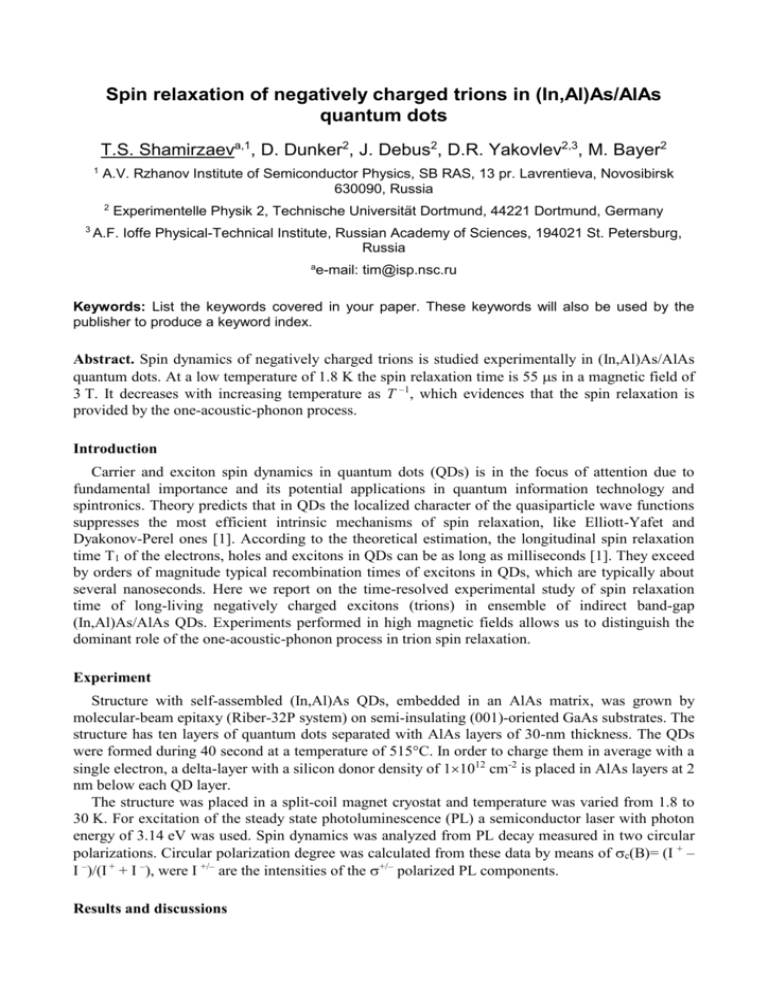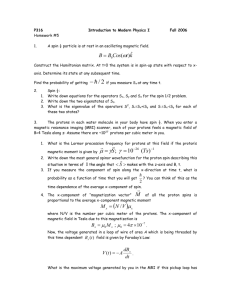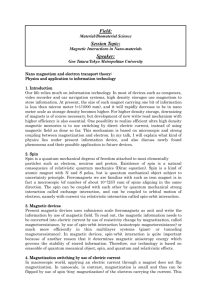paper template
advertisement

Spin relaxation of negatively charged trions in (In,Al)As/AlAs quantum dots T.S. Shamirzaeva,1, D. Dunker2, J. Debus2, D.R. Yakovlev2,3, M. Bayer2 1 A.V. Rzhanov Institute of Semiconductor Physics, SB RAS, 13 pr. Lavrentieva, Novosibirsk 630090, Russia 2 3 Experimentelle Physik 2, Technische Universität Dortmund, 44221 Dortmund, Germany A.F. Ioffe Physical-Technical Institute, Russian Academy of Sciences, 194021 St. Petersburg, Russia a e-mail: tim@isp.nsc.ru Keywords: List the keywords covered in your paper. These keywords will also be used by the publisher to produce a keyword index. Abstract. Spin dynamics of negatively charged trions is studied experimentally in (In,Al)As/AlAs quantum dots. At a low temperature of 1.8 K the spin relaxation time is 55 s in a magnetic field of 3 T. It decreases with increasing temperature as T –1, which evidences that the spin relaxation is provided by the one-acoustic-phonon process. Introduction Carrier and exciton spin dynamics in quantum dots (QDs) is in the focus of attention due to fundamental importance and its potential applications in quantum information technology and spintronics. Theory predicts that in QDs the localized character of the quasiparticle wave functions suppresses the most efficient intrinsic mechanisms of spin relaxation, like Elliott-Yafet and Dyakonov-Perel ones [1]. According to the theoretical estimation, the longitudinal spin relaxation time T1 of the electrons, holes and excitons in QDs can be as long as milliseconds [1]. They exceed by orders of magnitude typical recombination times of excitons in QDs, which are typically about several nanoseconds. Here we report on the time-resolved experimental study of spin relaxation time of long-living negatively charged excitons (trions) in ensemble of indirect band-gap (In,Al)As/AlAs QDs. Experiments performed in high magnetic fields allows us to distinguish the dominant role of the one-acoustic-phonon process in trion spin relaxation. Experiment Structure with self-assembled (In,Al)As QDs, embedded in an AlAs matrix, was grown by molecular-beam epitaxy (Riber-32P system) on semi-insulating (001)-oriented GaAs substrates. The structure has ten layers of quantum dots separated with AlAs layers of 30-nm thickness. The QDs were formed during 40 second at a temperature of 515°C. In order to charge them in average with a single electron, a delta-layer with a silicon donor density of 11012 cm-2 is placed in AlAs layers at 2 nm below each QD layer. The structure was placed in a split-coil magnet cryostat and temperature was varied from 1.8 to 30 K. For excitation of the steady state photoluminescence (PL) a semiconductor laser with photon energy of 3.14 eV was used. Spin dynamics was analyzed from PL decay measured in two circular polarizations. Circular polarization degree was calculated from these data by means of c(B)= (I + – I –)/(I + + I –), were I +/– are the intensities of the +/– polarized PL components. Results and discussions 10 30 B=6T 4 20 10 10 3 10 2 10 1 10 0 0 660 720 780 (nm) - 2 S (s) PL Intensity ( arb. units) (a) PL Intensity (arb. units) Low temperature PL spectrum (T=1.8 K) of negatively charged (In,Al)As/AlAs QDs is shown in the insert of Fig.1. The energy position of this band evidences that the conduction band minimum in these (In,Al)As/AlAs QDs belongs to the X-valley, i.e. is indirect in the momentum space. The indirect character of the band gap results in long exciton lifetime [2]. (b) 1 + T T = 1.8 K 0 0 20 40 t s) 60 -0.9 B=7T 0 10 20 Temperature (K) 30 Fig. 1. (a) Recombination dynamics of – and + polarized PL components measured at the QD band maximum at B = 6 T. Inset shows steady state PL spectrum. The energy of 1.72 eV where PL dynamics was measured is marked by an arrow. (b) Spin relaxation time s as a function of temperature measured at B = 7 T. Line is the best fit s(T) T -0.9. Negatively charged trion is constructed of two electrons and one heavy-hole and left in QD a resident electron after its recombination. The fine structure of the involved states splitted by magnetic field is determined by the sign of heave-hole and electron g-factors. As we found recently, both g-factors in indirect band gap (In,Al)As/AlAs QDs are positive [3]. The insert of Fig.3 shows a schematic diagram of the corresponding fine structure including its initial and final states as well as allowed optical transitions. The low (high) energy initial state has spin projection –3/2 (+3/2) and photon emitted from this state has polarization – ( +). Dynamics of the PL circular polarization degree at different magnetic fields is presented in Fig.1. It reflects termalization dynamics of trions on their Zeeman sublevels split by magnetic field. The thermalization dynamics of the trion spin states can be described by two-level rate equations: E exp dt S S k BT dn n n n E C exp , dt S S k BT dn C n n n (1), where С = С denotes pump rates, n and n are populations of the states with spin projection ±3/2, and s are trion lifetime and spin relaxation time, respectively. Intensity of + ( – ) PL component is proportional to n (n), therefore, the dynamics of the PL circular polarization degree is described by: c (t , , S ) n (t , , S ) - n (t , , S ) . n (t , , S ) n (t , , S ) (2) Using s as a free parameter, E B g h B , where B is the Bohr magneton, gh is the heavy-hole longitudinal g-factor we fit the experimental data (using from unpolarized PL decay) for the polarization degree dynamics from by Eq.(2) and estimate the trion spin relaxation times. Values of s determined with this technique at different temperatures are shown in Fig.2. One can see that the spin relaxation times follow a T -0.9 dependence. Figure 3 demonstrates s as a function of magnetic field. The dependence is well fitted by function s(B) B-5. Trion spin relaxation requires both changing its spin projection from +3/2 to -3/2 and dissipation energy of E. Typically energy relaxation is provided by interaction with phonons: emission (absorption) of one-acoustic-phonon [1] or two-phonon Raman process [4]. The change of trion spin projection can be provided by the spin-orbit interaction or by hyperfine-interaction with nuclear spins [1]. The latter is less favorable for the negatively charged trion where heavy-hole spin state is responsible for the spin relaxation. It was shown in numerous theoretical and experimental studies that spin relaxation times in twolevel systems in magnetic fields strongly depend on the ratio between Zeeman splitting and thermal energy E/kBT (and, therefore, on the magnetic field strength, since E B g h B ) [1,4]. In the case of E kBT, which occurs in our study, theory predicts that the magnetic field dependence of spin relaxation time is given by: (i) s(B) B-2 for two-phonon Raman process, (ii) s(B) B-3 for oneacoustic-phonon process under hyperfine-interaction with nuclear spins and, (iii) s(B) B-5 for oneacoustic-phonon process with spin-orbit interaction [1,4]. 2 S (s) 10 T = 1.8 K trion 1 10 B ~ -5 0 10 resident electron -1 10 0 2 4 6 8 10 Magnetic field (T) Fig. 3 Spin relaxation time s as a function of magnetic field. Line is a fit s(B) B-5. Inset shows fine structure of trion and electron spin states split in magnetic field for positive signs of electron and hole g-factors Our experimental data present clear s(B) B-5 dependence, which corresponds to the third spin relaxation mechanism. Temperature dependence of s(T) T -0.9 is also very close to expected for this mechanism T -1 dependence [4]. Conclusions In conclusion, spin dynamics of long-lived negatively charged excitons (trions) in indirect band gap (In,Al)As/AlAs quantum dots is investigated experimentally, giving rise to spin relaxation times as long as 55 s at B = 3 Т and cryogenic temperatures. The developed approach for modeling dynamics and steady state values of trion polarization degree with accounting for the strong dispersion of the trion lifetimes can be used for various material systems. Acknowledgements This work was supported by the Deutsche Forschungsgemeinschaft (Grant No. YA 65/5-3) and RFBR (Grant No.13-02-00073) T.S.S. acknowledges DFG financial support (Grant No. and YA 65/19-1). References [1] A.V. Khaetskii, Yu.V. Nazarov, Phys. Rev. B 64 (2001) 12316. [2] T. S. Shamirzaev, A.V. Nenashev, K. S. Zhuravlev, Appl. Phys. Lett. 92 (2008) 2130101. [3] J. Debus, T. S. Shamirzaev, D. Dunker, V. F. Sapega, E. L. Ivchenko, D. R. Yakovlev, K. S. Zhuravlev, and M. Bayer, “Fine structure of C-X mixed exciton in indirect band-gap (In,Al)As/AlAs quantum dots determined by spin-flip Raman scattering” (to be published).. [4] M. Trif, P. Simon, D. Loss, Phys. Rev. Lett. 103 (2009) 106601.








